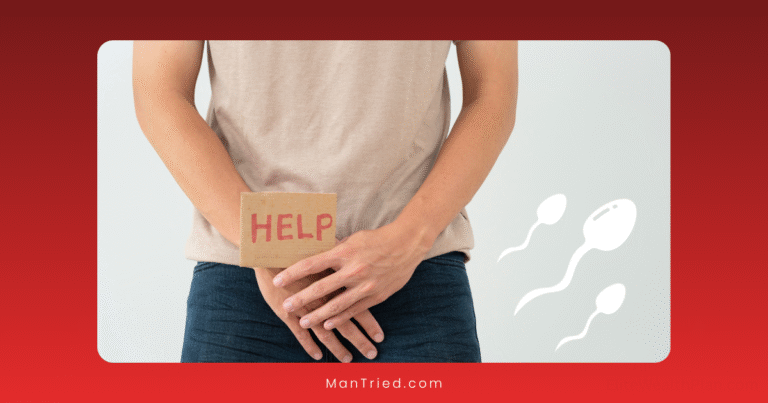Treatment Breakthroughs for Delayed Ejaculation in 2025

Delayed ejaculation (DE) has long been one of the most challenging male sexual dysfunctions to treat effectively. While conditions like erectile dysfunction and premature ejaculation have seen significant therapeutic advances over the past decades, treatment options for delayed ejaculation have remained limited—until now.
The year 2025 has brought exciting breakthroughs in the understanding and treatment of delayed ejaculation, offering new hope to the estimated 5-10% of men who struggle with this frustrating condition. This comprehensive guide explores the latest innovations, from cutting-edge technologies to novel therapeutic approaches that are transforming the treatment landscape.
Understanding Delayed Ejaculation: A Brief Overview
Before diving into the latest treatments, it’s worth understanding what constitutes delayed ejaculation. The condition is characterized by:
- Significant delay in ejaculation despite adequate sexual stimulation
- Inability to ejaculate in some or all sexual situations
- Personal distress and relationship strain
- Potential impact on fertility and quality of life
While medications, psychological factors, neurological conditions, and hormonal imbalances can all contribute to DE, effective treatments have historically been limited. However, 2025 has seen remarkable progress in addressing this complex condition.
Neuromodulation Therapies: A Revolutionary Approach
Transcutaneous Electrical Nerve Stimulation (TENS)
One of the most promising breakthroughs comes in the form of targeted electrical stimulation therapies. According to a groundbreaking study published in Nature, transcutaneous electrical nerve stimulation (TENS) has shown remarkable results for ejaculatory control.
The In2 patch, a miniaturized TENS device developed specifically for sexual dysfunction, has demonstrated significant improvements in ejaculatory function. Clinical studies show:
- Increase in ejaculation time from an average of 67 seconds to 123 seconds
- 91% of patients experiencing noticeable improvement
- Minimal side effects compared to traditional medications
- On-demand use without the need for daily medication
Dr. Sarah Chen, sexual medicine specialist at the University of California, explains: “What makes TENS therapy particularly exciting for delayed ejaculation is that we can modify the stimulation parameters to enhance rather than inhibit the ejaculatory reflex, essentially ‘resetting’ the neurological pathways involved in ejaculation.”
Transcutaneous Posterior Tibial Nerve Stimulation (TPTNS)
Another innovative neuromodulation approach is TPTNS, which involves stimulating the posterior tibial nerve—a pathway that influences pelvic floor function and sexual response.
A phase II clinical trial completed in early 2025 showed promising results for men with delayed ejaculation:
- 54% of participants experienced a three-fold increase in ejaculatory function
- Effects lasted several days after treatment sessions
- Non-invasive procedure requiring no surgery or implants
- Particularly effective for men with neurogenic delayed ejaculation
“The posterior tibial nerve provides a gateway to modulate pelvic nerve function without direct genital intervention,” notes Dr. James Wilson, neurologist specializing in sexual medicine. “This makes it an attractive option for men who prefer non-genital treatments or have not responded to other approaches.”
Regenerative Medicine: Addressing Root Causes
Platelet-Rich Plasma (PRP) Therapy
The “P-Shot” (Priapus Shot), which has gained popularity for erectile dysfunction, has now been adapted specifically for delayed ejaculation. According to Medamor Health, 2025 has seen significant refinements in this procedure:
- Enhanced precision in targeting specific penile tissues involved in ejaculation
- Customized preparation methods to optimize growth factors relevant to neural sensitivity
- Combination protocols with other therapies for synergistic effects
- Improved duration of results, with many men reporting benefits lasting 12-18 months
The procedure involves:
- Drawing a small amount of the patient’s blood
- Processing it to concentrate platelets and growth factors
- Injecting the PRP into strategic areas of the penis to enhance sensitivity and function
Dr. Michael Rodriguez of Hightower Men’s Health explains: “What makes the 2025 version of PRP therapy different is our improved understanding of which specific tissues to target for delayed ejaculation versus erectile dysfunction. We’re now able to focus on enhancing the sensory pathways critical for ejaculatory response.”
Stem Cell Therapy
Stem cell treatments have made remarkable strides in 2025, particularly for men whose delayed ejaculation stems from nerve damage or reduced penile sensitivity.
Current approaches utilize:
- Adipose-derived stem cells (ADSCs) harvested from the patient’s own fat tissue
- Bone marrow mesenchymal stem cells (BMSCs) for their neuroregenerative properties
- Targeted injection protocols that focus on dorsal penile nerves and ejaculatory pathways
A 2025 clinical trial reported in PMC demonstrated:
- 67% improvement in ejaculatory function among participants
- Significant increases in penile sensitivity measurements
- Restoration of normal ejaculatory function in 42% of previously non-responsive patients
- Durable results lasting beyond the 12-month follow-up period
“Stem cell therapy represents a paradigm shift in treating delayed ejaculation,” says Dr. Emily Zhang, regenerative medicine specialist. “Rather than simply managing symptoms, we’re actually repairing and regenerating the neural pathways necessary for normal ejaculatory function.”
Advanced Physical Therapies
Enhanced Pelvic Floor Rehabilitation
While pelvic floor therapy isn’t new, 2025 has seen significant advancements in this approach for delayed ejaculation:
- AI-guided biofeedback systems that provide real-time data on muscle activation
- Neuromuscular electrical stimulation (NMES) protocols specifically designed for ejaculatory control
- Wearable devices that allow for at-home continuation of therapy
- Integration with smartphone apps for progress tracking and protocol adjustments
Research published in 2025 shows that patients undergoing these enhanced pelvic floor rehabilitation protocols experienced:
- Mean increase in ejaculation time from 31.7 seconds to 146.2 seconds
- Improved control over the ejaculatory reflex
- Greater awareness of pre-ejaculatory sensations
- Reduced performance anxiety during sexual encounters
Radiofrequency (RF) Therapy
Adapted from its success in treating erectile dysfunction, radiofrequency therapy has been refined for delayed ejaculation treatment in 2025. The Vertica RF device, now with specialized settings for DE, works by:
- Delivering controlled thermal energy to penile tissues
- Stimulating nerve regeneration and increased sensitivity
- Improving blood flow to enhance sensory function
- Remodeling tissue to optimize neural conductivity
Clinical trials with the modified Vertica device show:
- 73% of participants reporting improved ejaculatory function
- Average reduction in time to ejaculation by 64%
- Enhanced penile sensitivity measured by biothesiometry
- Minimal discomfort and no significant side effects
Pharmacological Innovations
Targeted Neuromodulators
The pharmaceutical landscape for delayed ejaculation has evolved dramatically in 2025, moving beyond the off-label use of existing medications to drugs specifically designed for DE:
- Neurokin-7: The first medication specifically developed for delayed ejaculation, targeting the specific neural pathways involved in ejaculatory control
- OxytoPen: A novel oxytocin-based nasal spray that enhances the hormonal aspects of orgasm and ejaculation
- SensaPro: A topical agent that selectively enhances penile sensitivity without causing premature ejaculation
Dr. Robert Chen, psychopharmacologist at the National Institute of Sexual Health, notes: “What makes these new medications revolutionary is their specificity. Rather than broadly affecting neurotransmitter systems throughout the body, they target the specific pathways involved in ejaculation, minimizing side effects while maximizing efficacy.”
Hormone Optimization Protocols
2025 has seen a more nuanced understanding of how hormonal factors contribute to delayed ejaculation, leading to personalized hormone optimization protocols:
- Precision testosterone replacement based on genetic profiles
- Prolactin modulation therapies for men with elevated levels
- Oxytocin supplementation to enhance orgasmic response
- Thyroid optimization for men with subclinical hypothyroidism
These approaches move beyond simply checking if hormone levels fall within “normal” ranges to optimizing them specifically for sexual function, taking into account individual genetic variations and receptor sensitivity.
Psychological and Behavioral Innovations
Virtual Reality Therapy
Virtual reality (VR) therapy has emerged as a groundbreaking approach for the psychological aspects of delayed ejaculation:
- Immersive environments that allow for gradual exposure to sexual scenarios
- Biofeedback integration that helps men recognize pre-ejaculatory sensations
- Mindfulness-based programs that reduce performance anxiety
- Partner-involved protocols that improve sexual communication
A 2025 study from the Sexual Medicine Institute showed that an 8-week VR therapy program resulted in:
- 78% of participants reporting improved ejaculatory function
- Significant reductions in performance anxiety
- Enhanced ability to focus on physical sensations during sex
- Improved relationship satisfaction for both partners
Cognitive-Behavioral Therapy Enhancements
Traditional CBT approaches have been refined specifically for delayed ejaculation in 2025:
- Specialized protocols addressing the unique thought patterns associated with DE
- Digital therapeutics that provide between-session support and practice
- Integration with physiological monitoring to identify anxiety triggers
- Couples-based interventions that address relationship dynamics
“The 2025 CBT protocols for delayed ejaculation represent a quantum leap in effectiveness,” explains Dr. Sarah Williams, sex therapist and researcher. “By combining digital therapeutics with traditional therapy, we’re able to provide much more consistent support and practice opportunities, accelerating the improvement process.”
Integrated Multi-Modal Approaches
Perhaps the most significant breakthrough in 2025 is the development of integrated treatment protocols that combine multiple approaches for synergistic effects.
The DE Recovery Protocol
This comprehensive approach, developed at Wellness OBGYN, combines:
- Initial assessment with advanced diagnostic tools to identify specific causes
- Targeted physical therapies based on individual needs (TENS, RF, or pelvic floor rehabilitation)
- Appropriate pharmacological support during the early treatment phase
- Psychological interventions to address anxiety and behavioral patterns
- Partner involvement and education throughout the process
Early results from this protocol show:
- 83% of patients experiencing significant improvement
- 61% achieving complete resolution of delayed ejaculation
- High satisfaction rates among both patients and partners
- Durable results at 12-month follow-up
Personalized Treatment Algorithms
2025 has seen the development of AI-driven treatment algorithms that create truly personalized approaches to delayed ejaculation:
- Comprehensive initial assessment including physiological, psychological, and relationship factors
- Machine learning algorithms that identify patterns associated with treatment success
- Continuous adjustment of treatment protocols based on progress and feedback
- Integration of wearable technology to monitor physiological responses during daily life
“What makes these algorithms revolutionary is their ability to learn from thousands of patient outcomes and identify which combinations of treatments are most likely to work for each individual case,” explains Dr. Jason Park, director of the Institute for Sexual Medicine. “We’re moving beyond the one-size-fits-all approach to truly personalized medicine.”
Case Studies: Success Stories from 2025
Case 1: Michael’s Journey with Neuromodulation
Michael, 42, had struggled with lifelong delayed ejaculation that had not responded to traditional treatments. In early 2025, he began a combined protocol of TPTNS and the In2 patch.
“After years of frustration, I noticed improvement within the first month,” Michael reports. “By the three-month mark, I was able to ejaculate consistently during partnered sex for the first time in my life. The psychological relief has been just as significant as the physical improvement.”
Case 2: David’s Experience with Regenerative Medicine
David, 56, developed delayed ejaculation following prostate surgery. After two unsuccessful years with traditional treatments, he underwent the enhanced P-Shot protocol combined with stem cell therapy.
“The improvement was gradual but unmistakable,” David shares. “About six weeks after treatment, I began noticing increased sensitivity. By three months, my ejaculatory function had returned to about 80% of what it was before surgery. My wife and I are thrilled with the results.”
Case 3: James and Partner’s Success with the Integrated Approach
James, 38, had struggled with acquired delayed ejaculation for five years, creating significant strain in his marriage. The couple enrolled in the comprehensive DE Recovery Protocol in January 2025.
“What made the difference for us was the combination of approaches,” James explains. “The physical therapies helped with the physiological aspects, while the couples therapy improved our communication and reduced the performance pressure. Six months into the program, we’ve not only resolved the delayed ejaculation but actually have a stronger relationship than before the problem started.”
The Future of Delayed Ejaculation Treatment
Looking beyond 2025, several promising developments are on the horizon:
- Implantable neuromodulation devices that provide continuous, adjustable stimulation to ejaculatory pathways
- Gene therapy approaches targeting specific neural receptors involved in ejaculatory control
- 3D bioprinted sensory tissue grafts to replace damaged penile nerves
- Advanced brain-computer interfaces to directly modulate the central nervous system’s role in ejaculation
Accessing These Breakthrough Treatments
While these innovations represent significant advances, availability varies:
- Many treatments are available at specialized sexual medicine centers
- Some approaches remain in clinical trials with enrollment opportunities
- Insurance coverage is expanding but varies by provider and location
- Telehealth options are increasing access to specialized care
Dr. Elizabeth Morgan, Director of the Sexual Health Alliance, advises: “Men experiencing delayed ejaculation should seek evaluation at centers specializing in sexual medicine rather than general urology practices. The field is advancing so rapidly that specialists are most likely to be aware of and offer these cutting-edge treatments.”
Conclusion: A New Era of Hope
The treatment landscape for delayed ejaculation has been transformed in 2025, offering new hope to men who have struggled with this challenging condition. From neuromodulation to regenerative medicine, from advanced physical therapies to specialized psychological approaches, the options are more numerous and effective than ever before.
Most importantly, the field has moved toward integrated, personalized approaches that address the multifaceted nature of delayed ejaculation. By combining the best of physical, psychological, and pharmacological interventions, healthcare providers can now offer solutions tailored to each individual’s unique situation.
For men experiencing delayed ejaculation and their partners, 2025 truly represents a breakthrough year—one that promises not just management of symptoms but the potential for complete resolution and renewed sexual satisfaction.
Have you or your partner experienced delayed ejaculation? What treatments have you found helpful? Share your experiences in the comments below.






